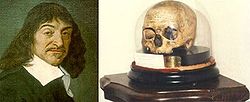100216
데카르트는 독살됐다?
‘근대철학의 아버지’로 불리는 르네 데카르트(1596~1650)는 스칸디나비아의 추운 겨울날씨 탓에 폐렴에 걸려 사망한 것으로 알려져 왔다. 그러나 데카르트 연구자인 독일 에를랑겐대학의 테오도르 에베르트 교수는 파리와 스톡홀름에 보관된 문서들을 검토한 연구보고서에서 “스톡홀름의 자크 비오구에 신부가 건네준 비소가 발라진 영성체빵을 먹고 비소중독으로 죽었다”고 주장했다고 <가디언>이 14일 보도했다. 비오구에 신부는 데카르트의 급진적 사상이 크리스티나 스웨덴 여왕의 가톨릭 개종에 장애가 될 수 있다고 생각했다는 것이다.
신 중심의 중세철학에서 인간과 이성 중심의 철학으로 전환으로 꾀했던 데카르트는 고향인 프랑스를 떠나 개신교국가인 네덜란드에서 거주하며 <방법서설>(1637년) 등을 출간했다.

데카르트는 개신교 국가인 스웨덴의 크리스티나 여왕의 초청을 받아 1649월 가을 스톡홀름으로 가게된다. 크리스티나 여왕은 새해를 맞으면서 국사에 방해가 되지 않도록 일주일에 세차례씩 새벽 5시에 철학 강의를 해줄 것을 요청했다. 데카르트는 여왕을 가르치기 시작한 지 2주일만에 감기에 걸렸고 일주일만에 폐렴으로 악화돼 사망했다고 공식 발표됐지만, 당시에도 독살설에 대한 소문이 파다했다.
에베르트 교수는 보고서에서, 주치의였던 반 불렌이 데카르트가 구토제 처방을 요구했다는 말과 함께 “오줌에서 피가 발견됐는데, 이것은 폐렴증세가 아니라 비소 같은 중금속에 의한 독중독의 증상”이라고 쓴 편지를 남겼다고 밝혔다. 데카르트의 스웨덴궁정 강의를 주선했던 당시 스톡홀름주재 프랑스대사도 “데카르트는 그의 죄없는 생명으로 그를 시기하는 자들을 속죄했다”는 의미심장한 비문을 남겼다.
데카르트의 죽음을 둘러싼 의문은 몸과 머리가 따로 프랑스로 돌아왔던 사연과도 관련이 있을 것으로 보인다. 지난 1666년 프랑스 정부는 위대한 철학자의 사후 귀국을 추진해 파리의 상제르맹데프레 교회에 그를 묻었다. 그러나 1791년 데카르트를 팡테옹으로 이전하기 위해 묘지를 발굴하면서, 시신에 두개골이 없다는 사실을 알게 됐다. 두개골은 1878년 스웨덴에서 경매에 붙여져 세상에 알려지게 됐고, 이 두개골은 현재 파리 인류박물관에 전시(사진)돼 있다. 두개골에는 “(유해수습작업 책임자였던) 스웨덴 근위대장 한스트림이 따로 보관해왔다”는 글귀가 새겨져 있다.
Descartes was 'poisoned by Catholic priest'
For more than three and a half centuries, the death of René Descartes one winter's day in Stockholm has been attributed to the ravages of pneumonia on a body unused to the Scandinavian chill. But in a book released after years spent combing the archives of Paris and the Swedish capital, one Cartesian expert has a more sinister theory about how the French philosopher came to his end.
According to Theodor Ebert, an academic at the University of Erlangen, Descartes died not through natural causes but from an arsenic-laced communion wafer given to him by a Catholic priest.
Ebert believes that Jacques Viogué, a missionary working in Stockholm, administered the poison because he feared Descartes's radical theological ideas would derail an expected conversion to Catholicism by the monarch of protestant Sweden. "Viogué knew of Queen Christina's Catholic tendencies. It is very likely that he saw in Descartes an obstacle to the Queen's conversion to the Catholic faith," Ebert told Le Nouvel Observateur newspaper.
Though raised as a Catholic, Descartes, who had been summoned in 1649 to tutor Queen Christina, was regarded with suspicion by many of his theological coreligionists. His theories were viewed as incompatible with the belief of transubstantiation, in which the bread and wine served during the Eucharist become the flesh and blood of Christ. "Viogué was convinced that … his metaphysics were more in line with Calvinist 'heresy'," said Ebert. The theory of foul play has been greeted with caution by scholars. Since Descartes's death on 11 February 1650, pneumonia has been blamed for robbing the world of the so-called father of modern philosophy.
Ebert rejects this as incompatible with the facts. In a letter written after his patient's death, Descartes's doctor, Van Wullen, described having found something wrong – which Ebert believes to be blood – in the philosopher's urine. "That is not a symptom of pneumonia; it is a symptom of poisoning, chiefly of arsenic," said Ebert, adding that Descartes asked his doctor to prescribe an emetic. "What conclusion is to be drawn other than the philosopher, who was well-acquainted with the medicine of his day, believed he had been poisoned?"